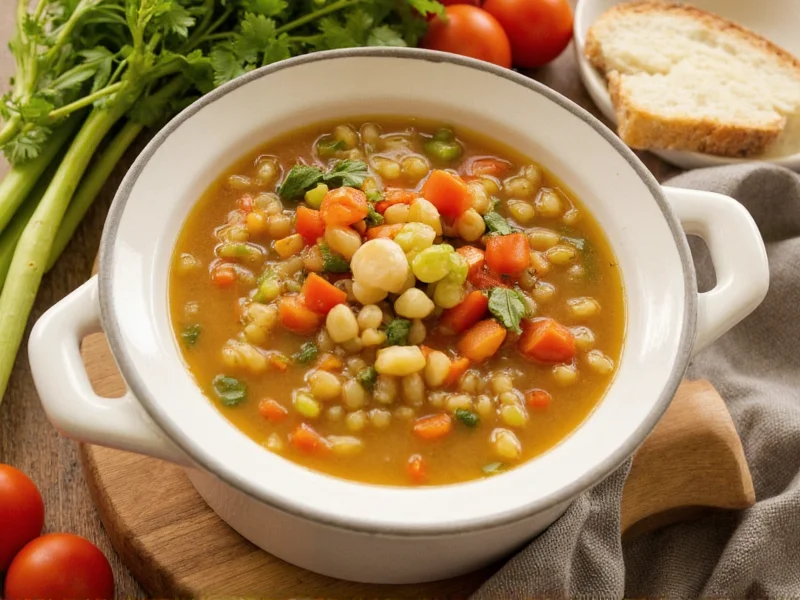Vegetable and barley soup stands as a nutritional powerhouse among comfort foods, offering both satisfying texture and significant health benefits. The combination of fiber-rich barley and diverse vegetables creates a meal that supports gut health while delivering essential vitamins and minerals. Unlike many creamy soups, this broth-based dish remains naturally low in fat while providing complex carbohydrates that promote steady energy levels throughout the day.
Why Barley Makes the Perfect Soup Base
Pearl barley, the most common variety used in soups, offers distinct advantages over other grains. Its chewy texture holds up well during cooking without becoming mushy, and it absorbs flavors beautifully while releasing just enough starch to naturally thicken the broth. Unlike refined grains, barley retains its bran layer during processing, preserving valuable nutrients and fiber. This whole grain contains approximately 6 grams of fiber per cooked cup—nearly double that of brown rice—and provides magnesium, selenium, and B vitamins essential for metabolic function.
Essential Ingredients for Optimal Flavor
The magic of vegetable and barley soup comes from layering flavors through strategic ingredient selection. Start with the holy trinity of mirepoix: diced onions, carrots, and celery sautéed in olive oil until translucent. Add garlic during the last minute of sautéing to prevent burning. For depth of flavor, include tomato paste cooked for 2-3 minutes before adding liquids. Choose low-sodium vegetable broth to control salt content, and select seasonal vegetables like zucchini in summer or parsnips in winter for peak freshness. Don't forget the acid finish—a splash of lemon juice or vinegar just before serving brightens the entire dish.
| Nutrient | Per Serving (1.5 cups) | Daily Value % |
|---|---|---|
| Calories | 185 | 9% |
| Total Fat | 3.5g | 4% |
| Saturated Fat | 0.5g | 3% |
| Cholesterol | 0mg | 0% |
| Sodium | 320mg | 14% |
| Total Carbohydrate | 34g | 12% |
| Dietary Fiber | 8g | 29% |
| Sugars | 6g | * |
| Protein | 6g | * |
Step-by-Step Cooking Method
Proper technique ensures perfectly cooked barley without mushy vegetables. Begin by rinsing ½ cup pearl barley under cold water to remove excess starch. Sauté aromatics (onion, carrot, celery) in 2 tablespoons olive oil over medium heat for 8-10 minutes until softened. Add 2 minced garlic cloves and 2 tablespoons tomato paste, cooking for 3 more minutes. Pour in 6 cups low-sodium vegetable broth and the rinsed barley, bringing to a boil. Reduce heat to low, cover, and simmer for 30 minutes. Add chopped vegetables like potatoes, zucchini, and green beans, then continue simmering for another 15-20 minutes until barley is tender but still chewy. Stir in leafy greens during the last 5 minutes of cooking. Finish with 1 tablespoon lemon juice and fresh herbs.
Nutritional Advantages of Regular Consumption
Regular consumption of vegetable and barley soup delivers measurable health benefits. The beta-glucan fiber in barley has been clinically shown to reduce LDL cholesterol levels by 5-10% when consumed daily. This soluble fiber also slows glucose absorption, making the soup an excellent choice for blood sugar management. The diverse vegetable content provides carotenoids and flavonoids that support immune function, while the high water content promotes hydration. Unlike many convenience foods, homemade vegetable barley soup contains no preservatives or artificial ingredients, making it suitable for most dietary patterns including vegetarian, vegan, and gluten-sensitive diets (when using certified gluten-free barley).
Storage and Reheating Best Practices
Vegetable and barley soup actually improves in flavor after 24 hours as ingredients meld. Store cooled soup in airtight containers for up to 5 days in the refrigerator or freeze for up to 3 months. When reheating, add a splash of broth or water as barley continues absorbing liquid during storage. For frozen portions, thaw overnight in the refrigerator before reheating. Avoid boiling when reheating to preserve vegetable texture—gentle simmering is sufficient. The soup's high fiber content means it reheats evenly in the microwave with occasional stirring.
Variations for Different Dietary Needs
This adaptable recipe accommodates various dietary requirements. For protein enhancement, add white beans or lentils during the last 20 minutes of cooking. Those following a low-FODMAP diet can substitute garlic-infused oil for fresh garlic and use only the green parts of scallions. To create a creamier texture without dairy, blend 1 cup of the finished soup and stir it back in. For an immune-boosting version, add grated ginger and turmeric during the sauté phase. Those managing sodium intake should use no-salt-added broth and increase herbs like thyme and rosemary for flavor without salt.
Avoiding Common Preparation Mistakes
Many home cooks make preventable errors when preparing vegetable and barley soup. Adding all vegetables at once results in some being overcooked while others remain underdone. Barley should never be added to boiling liquid without first sautéing aromatics, as this prevents flavor development. Using quick-cooking barley instead of pearl barley leads to disintegration during cooking. Overlooking the importance of acid at the end creates a flat-tasting soup. Finally, seasoning throughout the cooking process—not just at the end—builds complex flavor layers. Remember that barley expands significantly, so the soup will thicken upon standing.











 浙公网安备
33010002000092号
浙公网安备
33010002000092号 浙B2-20120091-4
浙B2-20120091-4